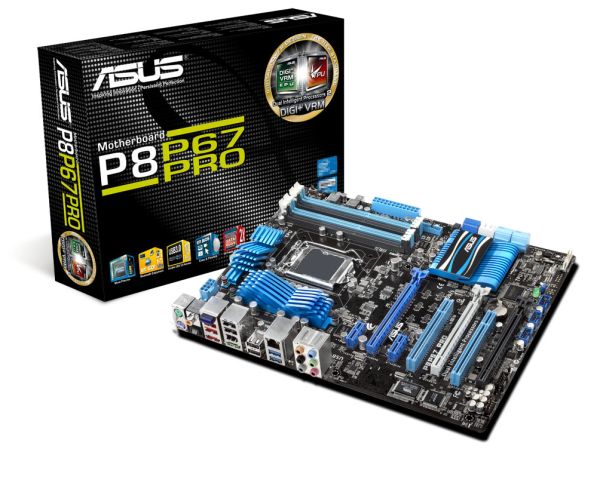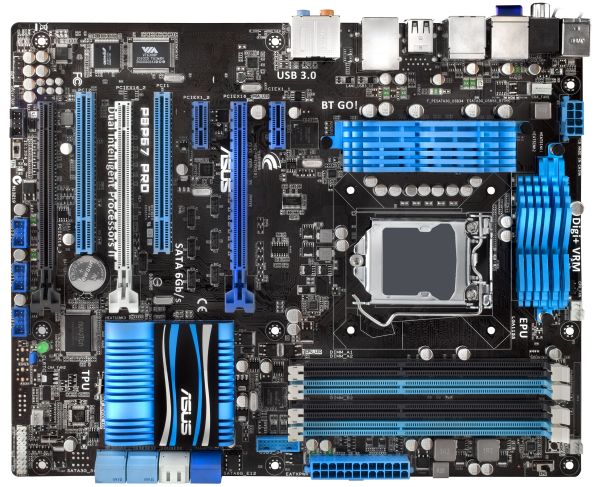A brief look at upcoming ASUS P67 Motherboards
by Ian Cutress on November 14, 2010 1:22 PM EST- Posted in
- News
- Motherboards
- Asus
On first inspection, this board’s aesthetic blue and black livery is impressive. The big blue heatsinks on the VRM, while looking good with a large surface area, intrude slightly on the socket, potentially resulting in restricting the orientation of high end air coolers.
Among the standard features you’d expect on a P67, such as the four dual-channel DDR3 slots, and four SATA 3Gb/s with two SATA 6Gb/s supported by the chipset, there is another two SATA ports, but it is unclear if these are for the RAID, 3Gb/s or 6Gb/s, or how they are powered, as they are not labelled and the chipset heatsink covers quite a bit. Two NEC controllers give two USB 3.0 ports on the back panel, and the possibility for another two via a header on the board connectable to the case, or to an ASUS USB 3.0 port box (as shown in the P67 Deluxe images). The Sandy Bridge platform on P67 relies on discrete graphics only, and as such there are no video out connectors on the back panel, but two PCIe x8 slots on the board itself (or one PCIe x16 if only one card is used). There is another PCIe slot available, presumably x4, for non-GPU duties.
The back panel itself is fairly standard – dual PS/2 ports for keyboard and mouse, S/PDIF out, six USB 2.0 ports, two USB 3.0 ports, two eSATA connectors, firewire, 5.1 audio and gigabit Ethernet. Also of note is the Bluetooth receiver, which is a nice addition, but the lack of a second gigabit Ethernet port, which by now we feel should be a staple on all high end boards and any board with the ‘Pro’ moniker, isn’t too pleasing.
On the board, we see two switches for TPU (TurboV Processing Unit) and EPU (Energy Processing Unit). The TPU is designed to monitor FET thermal temperatures, while the EPU will moderate power appropriately across the VRMs. Both can be turned on and off by the onboard switches, and presumably in the BIOS as well.
Speaking of switches, we’re disappointed that ASUS have not put easy-to-use power and reset switches on the Pro. Sure, not everyone needs them, but they are a nice addition rather than having to short two front panel pins with a screwdriver (when slightly tired, it’s never a good idea to accidentally short the wrong pins, unless you want to see some sparks).












53 Comments
View All Comments
Egowhip69 - Sunday, November 14, 2010 - link
Not really niche... More for professionals. Many medium and small shops use home made systems for workstations for money reasons. I work at a large Post house, and even we do that when money is tight and we can't afford the mainstream workstations (as they command a VERY large price premium).In our shop, most of our systems are SAN attached through fiber. CVFS (the filesystem we use) requires a secondary nic for "metadata". You can do everything through 1 nic, but at a huge preformance penalty if any latency exists.
Plus, with dual nics, you can setup you system as a router, DHCP server, firewall, print server, dual home the system in a work network, etc.
While I do agree, for 99% of the "high end" gamers won't need it... but for the $.30 it cost to throw the second nic on there... why not? Then your product applies to a larger portion of the users out there.
Taft12 - Monday, November 15, 2010 - link
The Realtek network chip these OEMs use is not at all fit for use in a professional environment.Now please pass me my Intel PCI-E NIC:
http://www.intel.com/products/server/adapters/pro1...
7amood - Sunday, November 14, 2010 - link
Would love to see ASUS get seriously into smaller mobos (mini-ITX).I am planning to use the SilverStone SG07 to build a small beast.
ONLY if ASUS put serious thought into building a good Mini-ITX mobo.
I am already planning two bios settings for it, quite mode where not even the behemoth fan of the SG07 is needed and the other for serious computation and gaming.
Qapa - Sunday, November 14, 2010 - link
The PC could live a lot longer if it moved to SFF, but mostly companies are taking 2 routes:1 - laptops
2 - PCs with the same old size from dozens of years!!
I wish they would focus on SFF as well, I'd make one for myself if it wasn't too damn hard to find the MBs, graphics, etc and at a similar price!
Egowhip69 - Sunday, November 14, 2010 - link
I agree, I love the smaller boards... but the reason the Mobo Manus concentrate on those two areas, is a simple answer... money.To shrink the board, you have to do alot more design and research. This ups the cost, so you have to charge more to recoup. And I don't think they sell even close to as many of the mini and pico boards as normal size ATX, probably cause they cost more.
Laptops are the hot item now. More sales means more money, which means more money going back into R&D into that area, which then makes the product better, which helps drive more sales. All a circle.
Boils down to money. I would like more small options, but until livingroom integration really takes off, I think it'll stay as a smaller niche market.
Mr Perfect - Monday, November 15, 2010 - link
I was going to ask the same thing, where are the mITX boards? Asus made a nice one for AM3s, so we know they're watching the market.Etern205 - Sunday, November 14, 2010 - link
The P8P67 Deluxe has UEFI bioshttp://www.techspot.com/news/40984-asus-motherboar...
After 3:00, look at the top left corner and you'll see the model.
May need to watch it on YouTube to get a clearer picture.
Pneumothorax - Sunday, November 14, 2010 - link
Since Intel's forcing you to by a chip with built in gfx, wouldn't be helpful for at least diagnostic purposes or even a "bad flash" to be able to boot up using the GMA core on Sandy Bridge?Stahn Aileron - Monday, November 15, 2010 - link
It's a P-series chipset. An H6x-series is probably where the intregrated GPU will be supported, much like how the current chipset work (P5x = Dedicated GPUs ONLY; H5x-series for CPUs with integrated GPU.)The question I have to ask is will ALL SB-based chips have a GPU in them, or will the higher-end (like the EE) chips use all the silicon for CPU cores? (I mean, if you're shelling out for a high-end CPU, you probaly have a high-end discrete GPU or a SLI/CrossFire set-up of some sort.)
nevcairiel - Monday, November 15, 2010 - link
All SB chips coming in the first generation (1155 chipset) will have the GPU cores. The 8-cores coming Q3/11 presumably won't have them.